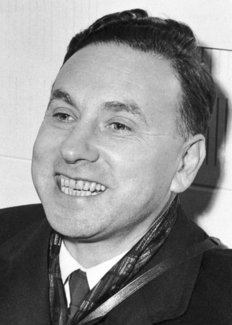Robert Hofstadter
Biographical

Robert Hofstadter, Professor of Physics at Stanford University, was born in New York, N.Y., of parents Louis Hofstadter and Henrietta Koenigsberg, on February 5, 1915.
Hofstadter attended elementary and high schools in New York City, and was graduated in 1935 from the College of the City of New York with the B.S. degree, magna cum laude.
On graduation from college Hofstadter received the Kenyon Prize in Mathematics and Physics, and a little later the Coffin Fellowship, awarded by the General Electric Company. He went to graduate school at Princeton University where he studied physics from 1935 – 1938, and received both the M.A. and Ph.D. degrees in 1938 from that institution. His Ph.D. work was concerned with infrared spectra of simple organic molecules, and in particular, with the partial elucidation of the structure of the now well-known “hydrogen bond”. In 1938 – 1939 he was awarded a Procter Fellowship at Princeton University for postdoctoral work, at which time he began a study of photoconductivity in willemite crystals. This work led to the discovery, with R. Herman, of the warm-up dark currents which demonstrated the existence of trapping states in crystals. In 1939 Hofstadter received the Harrison Fellowship at the University of Pennsylvania where he helped to construct a large Van de Graaff machine for nuclear research. At Pennsylvania he first met L. I. Schiff, who has been a friend and colleague for many years.
During the war years Hofstadter worked first at the National Bureau of Standards and later at the Norden Laboratory Corporation. He left industry at the end of the war to become Assistant Professor of Physics at Princeton University. At Princeton he carried out research on crystal conduction counters, on the Compton effect, and on scintillation counters. In 1948 he discovered that sodium iodide, activated by thallium, made an excellent scintillation counter. In 1950, with J. A. McIntyre, he found that well-formed crystals of this material provided remarkable energy-measuring devices for gamma rays and energetic particles and thus could be used as spectrometers in addition to gamma-ray and particle counters of high efficiency.
In 1950 Hofstadter left Princeton to become Associate Professor of Physics at Stanford University where he initiated a program on the scattering of energetic electrons from the linear accelerator, invented by W. W. Hansen, which was then under construction. While building equipment for the electron-scattering experiments, he continued working on scintillation counters and developed new detectors for neutrons and X-rays. High-speed inorganic (CsF) and useful Cerenkov (TlCl) counters were discovered at Stanford. Other studies carried out in the early years at Stanford were concerned with cosmic rays and with cascade showers generated by high-speed electrons.
After 1953 electron-scattering measurements became Hofstadter’s principal interest. With students and colleagues he investigated the charge distribution in atomic nuclei and afterwards the charge and magnetic moment distributions in the proton and neutron. The electron-scattering method was used to find the size and surface thickness parameters of nuclei. Many of the principal results on the proton and neutron were obtained in the years 1954-1957. Since 1957 emphasis in the research program has been placed on making more precise studies of the nucleon form factors. This work is still in progress.
Hofstadter was elected to the National Academy of Sciences (U.S.A.) in 1958 and was named California Scientist of the Year in 1959. He has also been a Guggenheim Fellow (1958 – 1959) and spent one year at CERN in Geneva, Switzerland, on sabbatical leave.
In 1942 he married Nancy Givan of Baltimore, Maryland, and they have a son, Douglas, and two daughters, Laura and Mary.
This autobiography/biography was written at the time of the award and first published in the book series Les Prix Nobel. It was later edited and republished in Nobel Lectures. To cite this document, always state the source as shown above.
Robert Hofstadter died on November 17, 1990.
Nobel Prizes and laureates
Six prizes were awarded for achievements that have conferred the greatest benefit to humankind. The 14 laureates' work and discoveries range from quantum tunnelling to promoting democratic rights.
See them all presented here.
